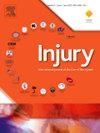Injury severity bias in missing prehospital vital signs: Prevalence and implications for trauma registries
IF 2.2
3区 医学
Q3 CRITICAL CARE MEDICINE
Injury-International Journal of the Care of the Injured
Pub Date : 2025-01-01
DOI:10.1016/j.injury.2024.111747
引用次数: 0
Abstract
Background
Vital signs are important factors in assessing injury severity and guiding trauma resuscitation, especially among severely injured patients. Despite this, physiological data are frequently missing from trauma registries. This study aimed to evaluate the extent of missing prehospital data in a hospital-based trauma registry and to assess the associations between prehospital physiological data completeness and indicators of injury severity.
Methods
A retrospective review was conducted on all adult trauma patients brought directly to a level 1 trauma center in Toronto, Ontario by paramedics from January 1, 2015, to December 31, 2019. The proportion of missing data was evaluated for each variable and patterns of missingness were assessed. To investigate the associations between prehospital data completeness and injury severity factors, descriptive and unadjusted logistic regression analyses were performed.
Results
A total of 3,528 patients were included. We considered prehospital data missing if any of heart rate, systolic blood pressure, respiratory rate or oxygen saturation were incomplete. Each individual variable was missing from the registry in approximately 20 % of patients, with oxygen saturation missing most frequently (n = 831; 23.6 %). Over 25 % (n = 909) of patients were missing at least one prehospital vital sign, of which 69.1 % (n = 628) were missing all four of these variables. Patients with incomplete data were more severely injured, had higher mortality, and more frequently received lifesaving interventions such as blood transfusion and intubation. Patients were most likely to have missing prehospital physiological data if they died in the trauma bay (unadjusted OR: 9.79; 95 % CI: 6.35–15.10), did not survive to discharge (unadjusted OR: 3.55; 95 % CI: 2.76–4.55), or had a prehospital GCS less than 9 (OR: 3.24; 95 % CI: 2.59–4.06).
Conclusion
In this single center trauma registry, key prehospital variables were frequently missing, particularly among more severely injured patients. Patients with missing data had higher mortality, more severe injury characteristics and received more life-saving interventions in the trauma bay, suggesting an injury severity bias in prehospital vital sign missingness. To ensure the validity of research based on trauma registry data, patterns of missingness must be carefully considered to ensure missing data is appropriately addressed.
院前生命体征缺失的伤害严重程度偏差:普遍性及其对创伤登记的影响。
背景:生命体征是评估损伤严重程度和指导创伤复苏的重要因素,尤其是对重伤患者而言。尽管如此,创伤登记中仍经常缺失生理数据。本研究旨在评估医院创伤登记中院前数据缺失的程度,并评估院前生理数据完整性与损伤严重程度指标之间的关联:对2015年1月1日至2019年12月31日期间由急救人员直接送往安大略省多伦多市一级创伤中心的所有成人创伤患者进行了回顾性审查。对每个变量的数据缺失比例进行了评估,并对缺失模式进行了评估。为了研究院前数据完整性与损伤严重程度因素之间的关联,研究人员进行了描述性和未调整的逻辑回归分析:共纳入 3528 名患者。如果心率、收缩压、呼吸频率或血氧饱和度中有任何一项数据不完整,我们就认为院前数据缺失。约有 20% 的患者登记表中的每个变量都有缺失,其中血氧饱和度缺失的比例最高(n = 831;23.6%)。超过 25% 的患者(n = 909)缺少至少一个院前生命体征,其中 69.1% 的患者(n = 628)缺少所有四个变量。数据不完整的患者受伤更严重,死亡率更高,接受输血和插管等救生干预的频率更高。如果患者在创伤室死亡(未调整 OR:9.79;95 % CI:6.35-15.10)、未能存活至出院(未调整 OR:3.55;95 % CI:2.76-4.55)或院前 GCS 低于 9(OR:3.24;95 % CI:2.59-4.06),则最有可能缺失院前生理数据:结论:在这一单中心创伤登记中,院前关键变量经常缺失,尤其是在伤势较重的患者中。数据缺失的患者死亡率较高,受伤特征更严重,在创伤室接受的救生干预更多,这表明院前生命体征缺失存在受伤严重程度偏差。为确保基于创伤登记数据的研究的有效性,必须仔细考虑数据缺失的模式,以确保缺失数据得到适当处理。
本文章由计算机程序翻译,如有差异,请以英文原文为准。
求助全文
约1分钟内获得全文
求助全文
来源期刊
CiteScore
4.00
自引率
8.00%
发文量
699
审稿时长
96 days
期刊介绍:
Injury was founded in 1969 and is an international journal dealing with all aspects of trauma care and accident surgery. Our primary aim is to facilitate the exchange of ideas, techniques and information among all members of the trauma team.

 求助内容:
求助内容: 应助结果提醒方式:
应助结果提醒方式:


